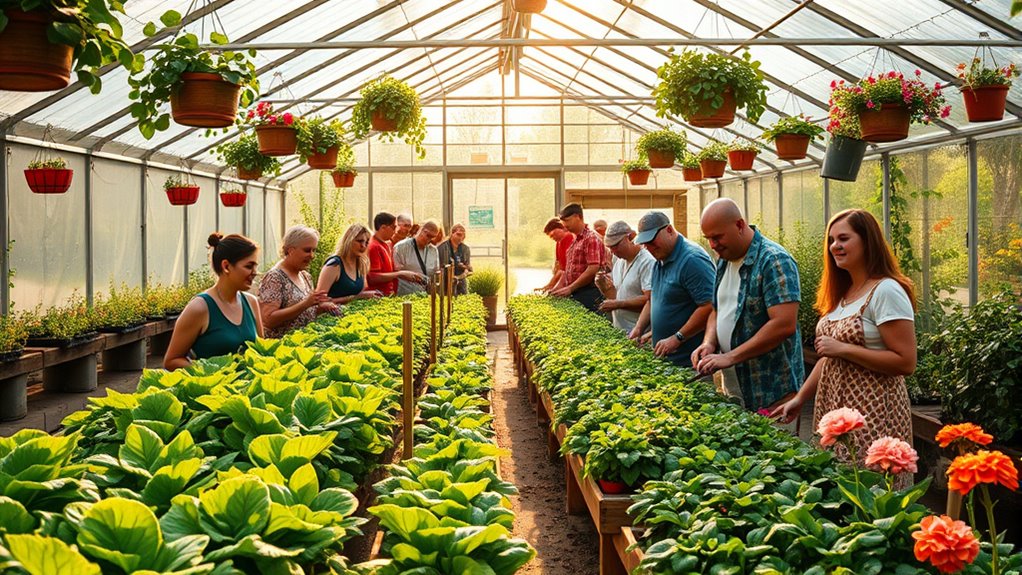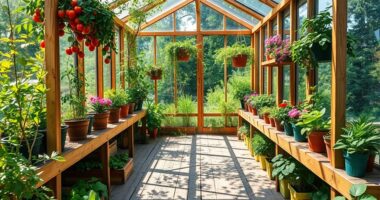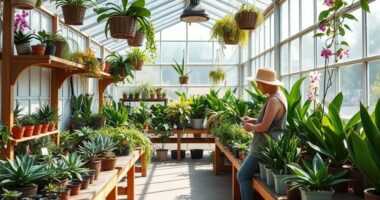Greenhouses in community gardens serve as vibrant social hubs that foster connections, education, and sustainable living. They provide accessible, inclusive spaces where you can help grow fresh produce, learn about plant care, and participate in community activities. These environments encourage collaboration across ages and backgrounds, strengthening bonds and promoting resilience. Smart technology and eco-friendly features make them efficient and engaging. Keep exploring to discover how these green spaces can transform your community life.
Key Takeaways
- Greenhouses serve as welcoming community spaces that facilitate social interaction and collaboration among diverse members.
- They support volunteer programs and community projects that strengthen local bonds through shared gardening efforts.
- Greenhouses can host workshops, art events, and cultural activities, fostering inclusivity and community engagement.
- Incorporating accessible design features encourages participation from all age groups and physical abilities.
- They act as vibrant hubs for education, skill-building, and social connection, enhancing neighborhood cohesion.
The Role of Greenhouses in Urban Agriculture
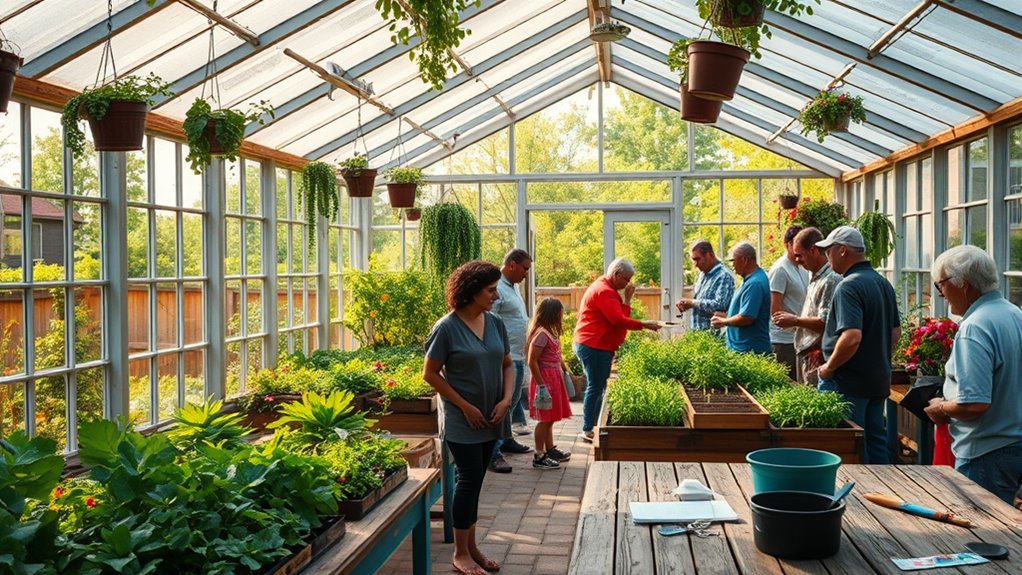
Greenhouses play a vital role in urban agriculture by extending growing seasons and providing a controlled environment for plants. Inside, you can implement hydroponic systems, which allow you to grow crops without soil, maximizing space and efficiency.
Using these systems, you can cultivate vegetables and herbs year-round, even in limited city spaces. Greenhouses also support organic practices, enabling you to avoid synthetic pesticides and fertilizers while maintaining healthy, sustainable crops.
This controlled setup makes it easier to monitor and manage pests, water usage, and nutrient levels, ensuring produce that’s fresh and safe. By incorporating hydroponic systems and organic methods, you create a sustainable urban farm that boosts local food production and reduces your environmental footprint.
Designing Inclusive Social Spaces Within Greenhouses

Creating inclusive social spaces within greenhouses transforms them from mere growing environments into vibrant community hubs. You should focus on accessible layouts that accommodate people of all ages and abilities, ensuring pathways are wide and free of obstacles. A well-designed greenhouse can also incorporate healthy fats and nutrient-rich options to support community health initiatives. Incorporating sustainable practices such as rainwater harvesting and composting can enhance environmental awareness and community engagement. Using efficient irrigation systems can further promote sustainability and resource conservation within these spaces. Incorporate seating areas that invite conversation and relaxation, making everyone feel welcome. Thoughtful placement of waterwick pots and other sustainable gardening tools can facilitate community participation and education. Emphasize cultural inclusivity by featuring diverse plant displays, artwork, and symbols that reflect the community’s backgrounds. Use multilingual signage and culturally sensitive design elements to foster a sense of belonging. By prioritizing accessibility and cultural awareness, you create a space where all community members can connect, share knowledge, and enjoy the environment.
Thoughtfully designed greenhouses become more than gardens—they become places of unity and cultural exchange.
Educational Opportunities Fostered by Greenhouse Environments
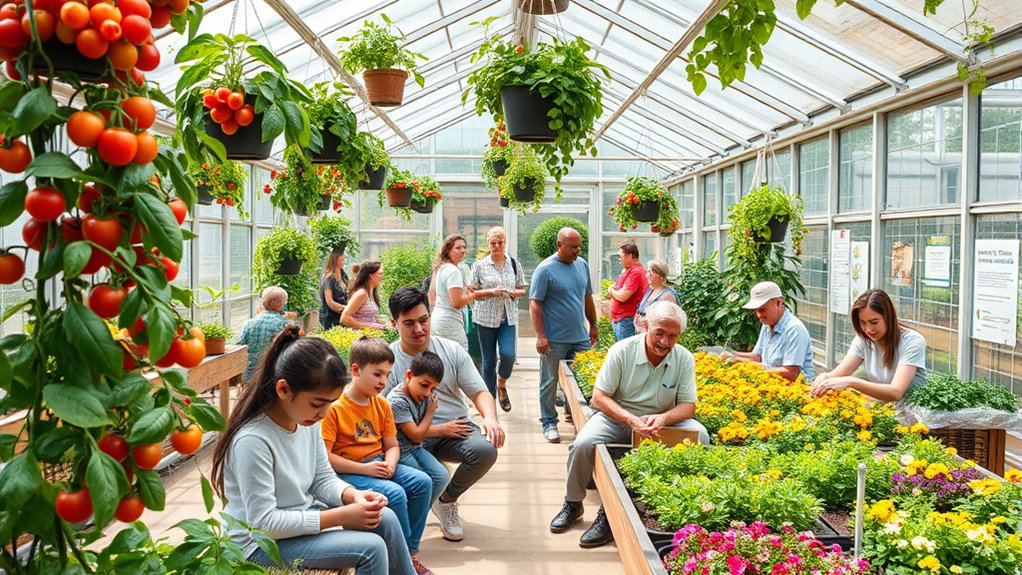
Greenhouses serve as dynamic educational platforms that inspire curiosity and deepen understanding of plant science, ecology, and sustainability. When you explore plant propagation, you learn how to grow new plants from seeds or cuttings, gaining practical skills and biological insights. Best vacuums for hardwood floors Greenhouses also offer hands-on experience with pest management, teaching you to identify pests and apply eco-friendly control methods. These environments encourage experimentation and observation, helping you grasp complex concepts like plant growth cycles and ecological balance. Additionally, engaging with soil health and nutrient management in greenhouse settings enhances comprehension of sustainable agricultural practices. Understanding plant genetics within greenhouse environments further enriches the learning experience by illustrating how traits are inherited and expressed. Moreover, studying plant growth regulators in greenhouses helps clarify how environmental factors influence development and productivity.
Greenhouses as Catalysts for Community Engagement

By providing a welcoming space for community members to come together, greenhouses actively foster social bonds and shared purpose. They become vibrant hubs for volunteer initiatives that strengthen local ties and encourage collaboration. As residents work side by side planting, maintaining, and harvesting, they build trust and camaraderie. Greenhouses also inspire community art projects, turning the space into a creative outlet that showcases local talent and promotes collective pride. Incorporating sustainable energy sources like solar or electric-powered equipment can make greenhouse activities more environmentally friendly and cost-effective. Utilizing energy-efficient methods helps reduce operational costs and minimizes environmental impact. Incorporating community engagement strategies further enhances participation and inclusivity, ensuring that diverse groups feel welcome. These activities invite diverse groups to participate, making the greenhouse a focal point for social engagement. By involving residents in hands-on projects and artistic expressions, greenhouses transform from mere structures into dynamic centers of community connection and empowerment, which can be further amplified through educational programs that teach sustainable practices and gardening skills.
The Environmental Benefits of Greenhouse Structures in Gardens
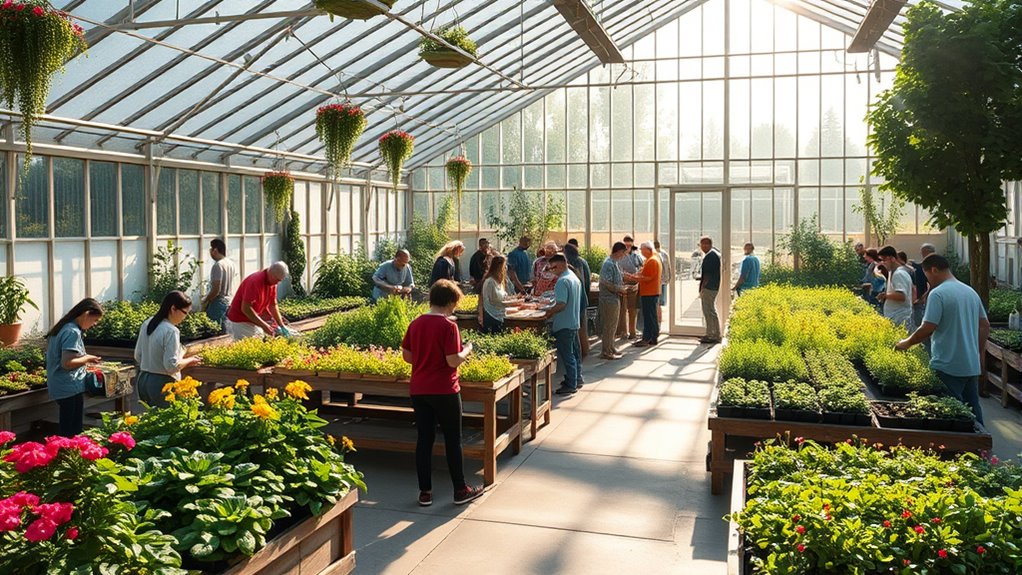
Greenhouse structures substantially enhance the environmental sustainability of community gardens. By providing a controlled environment, greenhouses boost photosynthesis efficiency, allowing plants to grow faster and healthier with ideal light and temperature conditions. Incorporating visual storytelling techniques, such as diagrams or photos, can further engage community members and promote understanding of sustainable gardening practices. Moreover, greenhouses can support local biodiversity by creating habitats for beneficial insects and native plant species, contributing to overall ecological health. Using greenhouses also enables better control over resource use, which can lead to significant reductions in water and energy consumption. This increased efficiency means you use fewer resources to produce more yield, reducing the garden’s overall environmental footprint. Additionally, greenhouses promote water conservation by minimizing evaporation and enabling precise watering techniques, so you use less water while maintaining healthy plants. Implementing energy-efficient systems like solar panels can further reduce the greenhouse’s carbon footprint. These structures also extend growing seasons, reducing the need for external resource inputs like fertilizers or pesticides. Overall, greenhouses help you create a more eco-friendly community garden that supports sustainable practices while maximizing productivity and conserving essential resources.
Success Stories: Greenhouses Strengthening Community Bonds

When community gardens incorporate greenhouses, they often see a remarkable boost in social cohesion. Greenhouses become vibrant centers for community outreach, inviting diverse groups to collaborate and share skills. A well-designed greenhouse can serve as an educational space, fostering community engagement and lifelong learning among residents. Volunteer initiatives flourish as residents team up to maintain the space, plant crops, and organize events. These activities foster a sense of ownership and trust among participants, breaking down social barriers. For example, in one city, a greenhouse project brought together seniors, youth, and newcomers, creating lasting friendships through shared gardening efforts. The greenhouse’s role as a social hub encourages ongoing involvement, empowering community members to work toward common goals. Additionally, the availability of resources such as portable gardening tools enhances participation and ease of use for all ages. Creating accessible and inclusive spaces enhances community participation, leading to stronger neighborhood bonds. Ultimately, these success stories highlight how greenhouses can strengthen bonds and build resilient, connected communities.
Future Trends in Greenhouse Integration for Community Well-Being
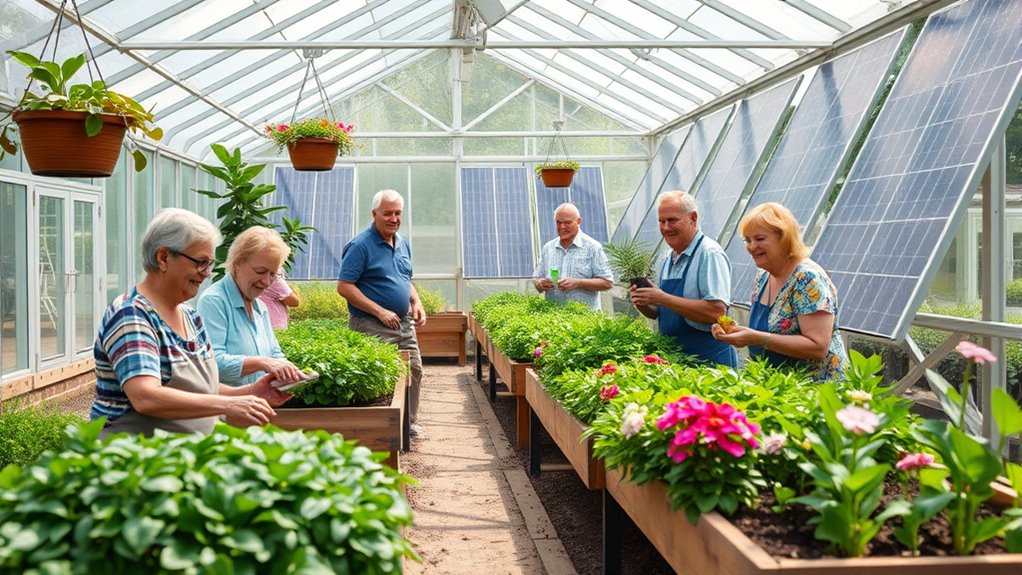
As technology advances, you’ll see more smart systems helping community greenhouses operate efficiently and engage residents.
Expanding green spaces in urban areas will make gardens accessible to more people, boosting overall well-being.
Additionally, inclusive programs will guarantee everyone can participate, strengthening community bonds and shared sustainability goals.
Smart Technology Adoption
How can emerging smart technologies transform community gardens and enhance their contribution to local well-being? By adopting innovations like smart irrigation and greenhouse automation, you can optimize resource use and improve crop yields. These technologies allow real-time monitoring of soil moisture, temperature, and humidity, ensuring plants get exactly what they need. Automated systems can adjust watering schedules and climate controls automatically, reducing waste and labor. Imagine a community garden where sensors alert you to water needs and control systems maintain ideal conditions effortlessly. Here’s a snapshot of potential smart integrations:
| Technology | Functionality | Impact |
|---|---|---|
| Smart irrigation | Precise watering based on sensor data | Saves water, boosts plant health |
| Greenhouse automation | Automated climate control | Enhances growth, reduces labor |
| Soil sensors | Monitor moisture and nutrients | Promotes optimal soil conditions |
| Data analytics | Track plant health trends | Informs better gardening decisions |
| Remote management | Control systems via apps | Increases accessibility and convenience |
Urban Green Space Expansion
Emerging smart technologies in community gardens are paving the way for expanding urban green spaces, making them more accessible and sustainable. These innovations support urban planning efforts by integrating green initiatives into city landscapes and encouraging policymakers to prioritize green space development.
As a result, cities can better accommodate growing populations and climate challenges. Policy development now emphasizes creating multi-use green zones that include community gardens and greenhouses. Smart tech enables efficient land use and resource management, fostering healthier environments.
- Incorporate green spaces into urban planning strategies
- Develop policies that incentivize green infrastructure
- Use technology to optimize green space distribution and maintenance
Inclusive Community Programs
Will community programs soon become more inclusive by integrating greenhouses to enhance overall well-being? Greenhouses can serve as vibrant centers for community participation, inviting diverse groups to share in gardening and learning experiences.
By designing programs that celebrate cultural inclusivity, you create spaces where everyone feels valued and represented. Greenhouses encourage collaboration across different backgrounds, fostering understanding and connection.
Future initiatives might include multilingual workshops, culturally specific crops, and activities that honor various traditions. This approach not only broadens access but also strengthens social bonds.
As greenhouses become integral to community programs, they help build more equitable, engaging environments where all members can contribute, learn, and thrive together.
Frequently Asked Questions
How Do Greenhouses Impact Local Food Security?
Greenhouses boost local food security by supporting urban agriculture, allowing you to grow fresh produce year-round regardless of weather. This helps you and your community achieve greater food sovereignty, reducing reliance on external food sources.
What Funding Options Support Community Greenhouse Projects?
Imagine a small community coming together to grow fresh produce inside a vibrant greenhouse. You can support this by exploring grant opportunities from local governments or nonprofit organizations that focus on urban agriculture.
Crowdfunding campaigns are also a great way to rally community members and secure funding. These options help turn visions into reality, fostering social bonds and promoting local food security through sustainable greenhouse projects.
How Can Greenhouses Promote Mental Health in Communities?
Greenhouses can substantially boost mental well-being by providing a calming environment where you can connect with nature. They foster social cohesion, encouraging community members to work together and share experiences.
As you engage in planting and caring for plants, you reduce stress and anxiety, promoting emotional health. Greenhouses serve as inclusive spaces where everyone can find comfort, build relationships, and enjoy the therapeutic benefits of nature, strengthening community bonds.
What Maintenance Challenges Do Community Greenhouses Face?
Think of maintaining a community greenhouse as tending a delicate garden maze. You deal with pest control challenges, keeping pests at bay without harming plants.
Proper ventilation systems are your invigorating change of air, preventing mold and overheating. Regularly inspecting and cleaning these systems ensures a healthy environment.
Addressing these maintenance challenges keeps your greenhouse thriving, so the community can enjoy fresh produce and a vibrant social space.
How Do Greenhouses Adapt to Climate Change Effects?
You can enhance greenhouse resilience to climate change by adopting adaptive designs that respond to shifting weather patterns. Incorporate climate resilience strategies like adjustable shading, improved insulation, and rainwater harvesting. These modifications help maintain ideal conditions inside, despite external fluctuations.
Conclusion
So, next time you step into a community greenhouse, remember—you’re entering more than just a space for plants. It’s where social bonds bloom, education thrives, and eco-friendly dreams take root. Who would’ve thought that a simple glass structure could become the heart of a community? Ironically, it’s often these very green spaces that remind us how interconnected we truly are—proving that sometimes, the most unexpected places grow the strongest bonds.
